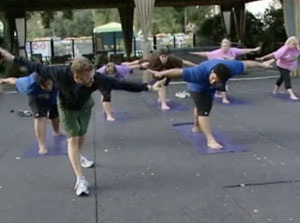 It’s almost time for another season of The Biggest Loser. In anticipation, I am dedicating my blogs this week to tips for how you can get The Biggest Loser experience at home. As the experts behind the show explain, one of the reasons the people lose so much weight consistently is because of their new environment. But you can change your environment at home, too. Biggest Loser success is within everyone’s reach. Earlier this week, I blogged about how you can change your nutrition and exercise environments, today I’m going to review a series of important behavior changes that will help you lose weight with the contestants.
It’s almost time for another season of The Biggest Loser. In anticipation, I am dedicating my blogs this week to tips for how you can get The Biggest Loser experience at home. As the experts behind the show explain, one of the reasons the people lose so much weight consistently is because of their new environment. But you can change your environment at home, too. Biggest Loser success is within everyone’s reach. Earlier this week, I blogged about how you can change your nutrition and exercise environments, today I’m going to review a series of important behavior changes that will help you lose weight with the contestants.
Since the first season, experts behind the scenes of the show found the contestants shared many characteristics, which I listed below along with tips for changes you can make along with the contestants:
No idea of the number of calories they need or what they actually consume.
Your behavior change solution: Try the DietsInReview.com health calculator to determine your calorie needs. Visit www.mypyramid.gov to journal your food intake to compare your needs to what you actually consume.
Most skip breakfast and snacks and let a long time go between meals.
Don’t skip any meals and eat every 3-4 hours. Don’t let more than 5 hours go between meals. You have to eat to lose weight – it’s what you eat that matters most.
Most consume very little fruits and vegetables.
If you follow the Biggest Loser diet I introduced earlier this week, you will follow the 4-3-2-1 plan that has you eating 4 cups of fruits and vegetables a day. Get 1/2 cup of fruit with fat-free Greek yogurt at breakfast, 2 cups of veggies as a lunch salad, 1 cup of raw veggies as a snack or with dinner, and 1/2 cup of fruit with dinner.
Most are not getting enough protein, and what they do get is high in saturated fat.
Choose lean protein and try to get fish most days of the week. Choose canned tuna, white fish, or salmon. Shrimp is also low in saturated fat. Chicken, pork, and beef with no skin and visible fat trimmed can be healthy, too. Have tuna on your lunch salad and beef or pork at dinner. Vegetarian? No problem! Beans and rice are an excellent source of protein. Try black beans, cannelini beans, and lentils.
Most get very little whole grains.
The Biggest Loser diet has very little grain servings, so you gotta make them whole grains. Whole wheat products, corn, brown rice, and quinoa are just a few examples.
Most have too much “white stuff” (sugar, refined flour).
If you follow The Biggest Loser Diet to the letter, you aren’t eating products with these ingredients.
Little planning of meals, mostly on-the-go eating and dining out.
Reserve about 3 hours a week to plan your meals, make a grocery list, and shop for the ingredients. This will save you time, calories, and money because you won’t need to dine out or worry about on-the-go eating.
Most are meeting their daily caloric needs through beverages alone (e.g. caloric sodas, juices and fruit punch).
This is just plain scary. Don’t drink your calories. The exception for me is fat free milk. You can include fat free milk in oatmeal or with a piece of whole wheat toast with a tablespoon of almond butter. Milk has calcium, vitamin D, and natural protein and carbs.
Many consume very little water.
If you aren’t drinking calories, you’re drinking water to stay hydrated. Try infusing water with lemon or orange slices. I also like to brew herbal tea and keep it cold. I mix it with carbonated water for a fizzy, calorie-free drink.
Nearly all reported limited to no exercise.
If you read my article earlier this week about the Biggest Loser workout, you know you should be getting 7 hours of exercise so this change is easy for you! If you haven’t yet worked up to 7 hours, keep up with what you are able to do and add 30 minutes a week.
Nearly all prioritize everything and everyone else in their life ahead of their own health.
It’s great you have people in your life who you love, but don’t you want to be there for them as long as possible? That means you have to be a little selfish and make the time to workout, insist on healthy meals for the family, and make sure everyone gets their sleep. No lounging at the computer and TV at night on a usual basis. Set limits on these things that don’t add quality and health to your life. Before you know it, you’ll wonder how you ever got along being so sedentary and eating so sluggishly.
